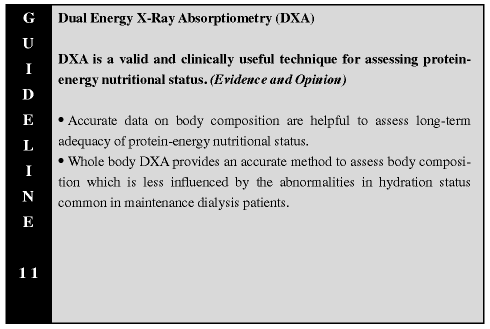
1. Evaluation of Protein-Energy Nutritional Status

Assessment of body composition, particularly with serial evaluation, can provide information concerning the long-term adequacy of protein-energy nutritional intake.58,99 Most clinically useful techniques for measuring body composition are not very precise unless obtained by trained anthropometrists using standardized methods, such as in Guideline 10. Whole body dual energy x-ray absorptiometry (DXA) is a reliable, noninvasive method to assess the three main components of body composition (fat mass, fat-free mass, and bone mineral mass and density). The accuracy of DXA is less influenced by the variations in hydration that commonly occur in ESRD patients.100-102 In vivo precision and accuracy of fat mass estimates by DXA are approximately 2% to 3% and 3%, respectively, in MHD101 and CPD patients. Studies of DXA in CRF, MHD, and CPD patients have demonstrated the superior precision and accuracy of DXA as compared with anthropometry, total body potassium counting, creatinine index, and bioelectrical impedance (BIA).80,100-102
DXA scanning utilizes an x-ray source that produces a stable, dual-energy photon beam.80,100-102 These beams are projected through the body by scanning in a rectilinear raster pattern. Various tissues (fat, fat-free mass, and bone) attenuate the x-ray beams to different extents. Body composition is computed from the ratios of the natural logarithms of the attenuated and unattenuated beams.
The main limitations to DXA are the substantial cost of acquiring the instrument, the requirement for dedicated space to house it, the costs for the DXA measurement, and the fact that individuals may need to travel to the DXA facility for the measurements. DXA also does not distinguish well between intracellular and extracellular water compartments. However, DXA scanners are becoming increasingly common in metropolitan settings. Where precise estimates of body composition and bone mineral density are required, use of DXA is preferred over traditional anthropometric techniques or BIA. However, the routine use of DXA is not recommended.